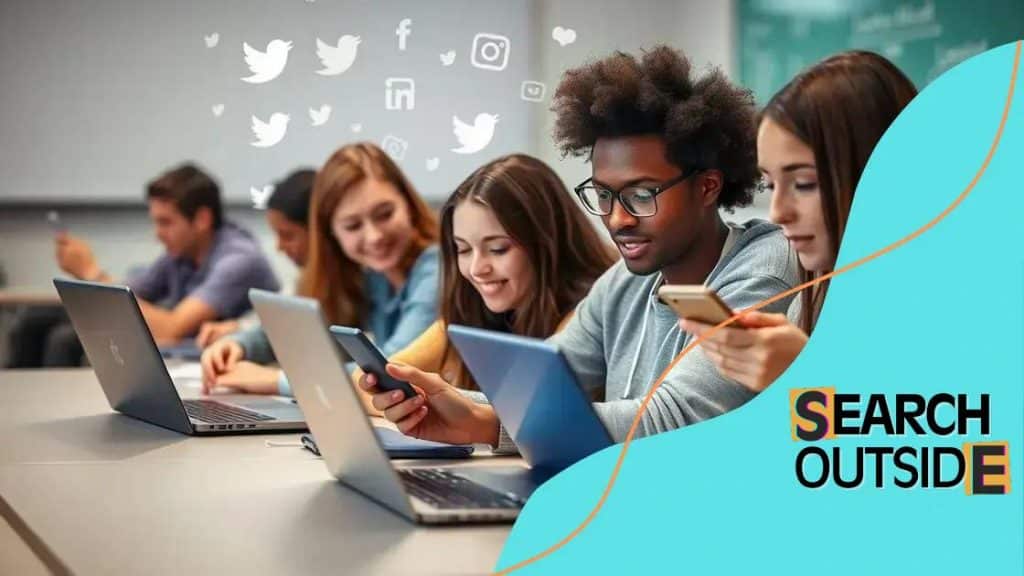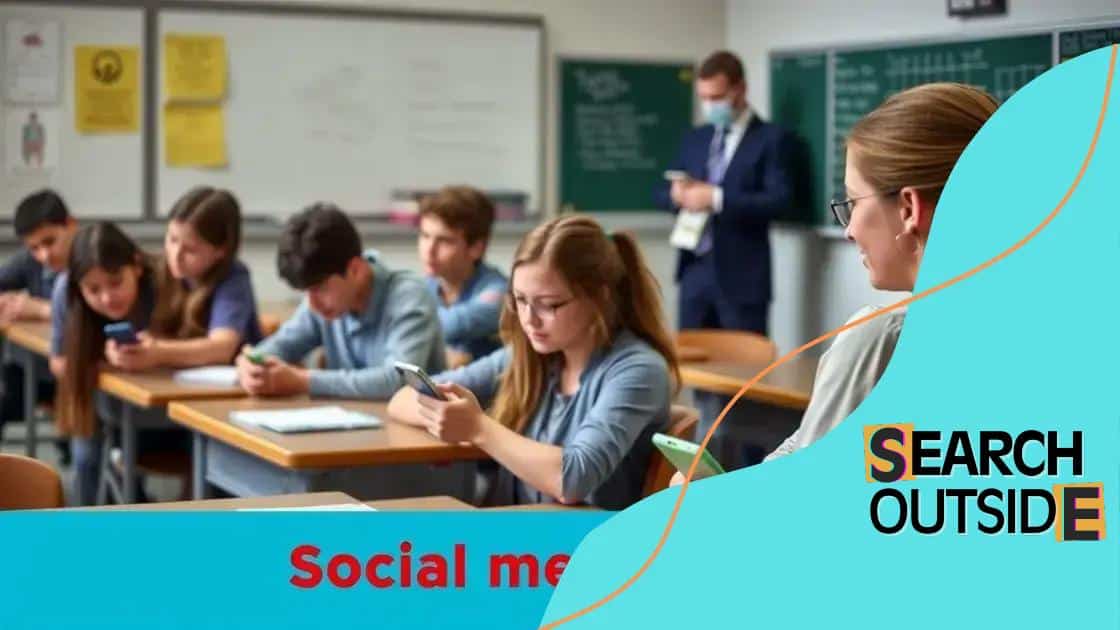The role of social media in modern learning environments

The role of social media in modern learning environments enhances student engagement, enables personalized learning experiences, and fosters collaboration, while also presenting challenges like distractions and privacy concerns that educators must address.
The role of social media in modern learning environments is becoming increasingly significant. Have you ever wondered how platforms like Twitter or Instagram can enhance education? Let’s explore this evolving landscape together.
Understanding the impact of social media on education
Understanding the impact of social media on education is essential in today’s digital age. These platforms can play a pivotal role in enhancing the learning experience for students. With millions of users engaging daily, educators are finding innovative ways to incorporate social media into their teaching methods.
Engagement and Interaction
One of the main benefits of using social media in education is increased engagement. Platforms like Facebook, Twitter, and Instagram offer unique ways for students to connect with their peers and teachers. This interaction can make learning more enjoyable and collaborative.
- Students can share ideas and resources instantly.
- Teachers can provide immediate feedback and support.
- Class discussions can extend outside of the classroom.
Another important aspect is the accessibility of information. Students can easily access a wealth of knowledge from various sources. This availability encourages independent learning and critical thinking. Social media can serve as a tool for students to explore topics in depth and connect with experts worldwide.
Creating a Sense of Community
Moreover, social media helps create a sense of community among students. Online study groups can form, allowing students to work together towards common goals. This sense of belonging can be crucial for student motivation and success.
Additionally, educators can create dedicated groups for their classes. This allows students to share resources, ask questions, and work collaboratively. Many platforms also have features that allow for easy dissemination of information, such as event reminders and announcements.
On the flip side, it is vital to address the challenges that come with social media use in education. Issues like distractions and cyberbullying can arise. Students must learn to navigate these challenges to make the most of their online learning experience.
- Establishing guidelines for appropriate behavior.
- Encouraging positive interactions.
- Monitoring usage to ensure safety.
By understanding both the benefits and challenges, educators can effectively integrate social media tools into their lessons, ensuring a balanced approach to learning.
The benefits of using social media for learning
The benefits of using social media for learning are vast and impactful. By integrating these platforms into educational practices, students can experience a richer learning environment.
Enhanced Communication
One significant advantage is improved communication. Social media allows students to connect with peers and instructors outside of traditional classroom settings. This open line of communication fosters collaboration and encourages students to share their ideas freely.
- Students can ask questions and get immediate responses.
- Group projects become easier to coordinate.
- Feedback from teachers is more accessible.
Additionally, social media enables the sharing of diverse perspectives. When students interact with classmates from different backgrounds, they gain new insights that enhance their understanding of various subjects. This exposure can lead to deeper discussions and critical thinking.
Access to Resources
Another important benefit is the access to abundant resources. Students can easily find tutorials, articles, and videos relevant to their studies on platforms like YouTube, Twitter, or LinkedIn. This abundance of information supports independent learning and helps students explore topics beyond the syllabus.
- Online forums provide additional support from a global community.
- Learning tools and apps enhance the educational experience.
- Students discover different learning styles and strategies.
Moreover, social media is an excellent platform for promoting active engagement. By participating in discussions and online communities, students can develop their communication skills and confidence. These interactions not only aid learning but also prepare them for real-world situations.
Incorporating social media into learning environments also encourages creativity. Students can express themselves through various formats, like videos, podcasts, or blogs. This freedom of expression helps them develop unique perspectives and enhances their overall learning journey.
Challenges and concerns related to social media in classrooms

Challenges and concerns related to social media in classrooms are important to consider. While there are many benefits, there can also be negative effects that impact students’ learning experiences.
Distractions and Engagement
One major challenge is the potential for distractions. With social media at their fingertips, students may find it hard to focus on their studies. Instead of engaging with learning materials, they might be tempted to check notifications or scroll through feeds.
- Frequent updates can interrupt attention spans.
- Group chats may lead to off-topic discussions.
- Students may multitask, affecting homework quality.
Furthermore, the usage of social media can lead to disengagement in traditional classroom settings. If students are more interested in their online interactions, they might miss out on valuable face-to-face discussions and collaborations.
Cyberbullying and Online Behavior
Another significant concern is cyberbullying. Social media platforms can sometimes create environments where bullying occurs. Negative comments and harassment can happen when students feel anonymous online, leading to severe impacts on mental health.
Students must learn to navigate these challenges responsibly. Educators play a critical role in teaching students about proper online behavior and the importance of empathy and respect in online interactions. They can establish guidelines for interactions and encourage a culture of positivity.
Privacy and Safety Issues
Privacy is also a critical issue. Students may not understand how to protect their personal information online. They may share details that could compromise their safety or lead to negative consequences later.
- Educating students about privacy settings is vital.
- Encouraging critical thinking regarding what to share is essential.
- Teachers should foster open discussions about online safety.
Incorporating social media into education requires careful planning and consideration of these challenges. By addressing these issues proactively, educators can help students enjoy the benefits of social media while minimizing potential drawbacks.
Best practices for integrating social media in education
Best practices for integrating social media in education can enhance the learning experience. By using these strategies, educators can create a productive and safe environment.
Establish Clear Guidelines
One of the first steps is to establish clear guidelines for social media use in the classroom. This helps students understand the expectations for behavior.
- Define appropriate content to share.
- Set boundaries regarding online communication.
- Encourage respectful interactions among peers.
Consistent guidelines can help prevent misunderstandings and promote a positive atmosphere. Teachers should regularly revisit these guidelines to ensure students remain aware of them.
Incorporate Engaging Activities
Integrating engaging activities related to social media can boost student interest. Using interactive projects encourages students to use these platforms creatively and educationally. For example, projects that require students to create informative videos or podcasts can be both fun and beneficial.
- Create a class hashtag for discussions.
- Encourage students to follow relevant educational accounts.
- Host online debates or discussions using social media.
These activities help students build their skills while also making learning enjoyable. They can learn not only academic content but also how to communicate effectively online.
Focus on Digital Citizenship
Teaching digital citizenship is also crucial when integrating social media. Students need to understand their responsibilities while using these platforms. Discussions on privacy, safety, and the impact of their online presence are essential.
By fostering an awareness of digital citizenship, educators can help students navigate the online world safely. This knowledge will benefit them in school and beyond, equipping them for future success.
Collaboration among teachers is key to effectively integrating social media. Educators can share resources, strategies, and experiences to enhance their practices. This teamwork creates a broader support system that can lead to more innovative uses of social media in education.
Future trends in social media and learning environments
Future trends in social media and learning environments are evolving rapidly. As technology advances, the way students and teachers interact will also change significantly.
Increased Personalization
One trend is the increasing personalization of learning experiences. With the help of social media, educators can tailor content to meet individual student needs. This personalization allows students to engage with materials that resonate with their personal interests and learning styles.
- Adaptive learning platforms will analyze student performance.
- Content will be customized based on student interactions.
- Students will have more control over their learning paths.
This shift encourages active participation and fosters a deeper understanding of the subjects being taught.
Integration of Virtual Reality
Another exciting trend is the integration of virtual reality (VR) within social media educational tools. VR can create immersive learning environments where students can explore complex concepts in an interactive way.
Imagine studying history by virtually visiting ancient civilizations or learning chemistry through interactive simulations. These experiences can make learning more engaging and memorable.
Collaborative Learning through Social Platforms
The rise of collaborative learning is another key trend. As social media platforms develop, they will provide more opportunities for students to work together across distances. This collaboration fosters teamwork and communication skills.
- Students can share their projects and receive feedback instantly.
- Group projects can involve peers from different schools or countries.
- Online peer tutoring networks can emerge, enhancing learning.
Social media will continue to play a crucial role in connecting students with global resources, experts, and peers, enriching their educational experiences.
Lastly, as schools move towards policies promoting digital literacy, students will learn about responsible online behavior and effective communication. This education ensures that they are prepared for a future where social media will be integral to both their personal and professional lives.
Conclusion:
The future of education with social media is bright and full of possibilities. As we see advancements in technology, integrating social media into learning will become even more essential. Students will benefit from personalized learning experiences, engaging with interactive content, and collaborating with peers across the globe. It’s important to address the challenges and maintain focus on teaching responsible online behavior. Embracing these changes can lead to richer educational experiences, better communication skills, and preparatory groundwork for future careers.
FAQ – Questions about the role of social media in modern learning environments
How can social media enhance student engagement?
Social media can increase engagement by allowing students to communicate collaboratively, share ideas, and participate actively in discussions.
What are some challenges of using social media in education?
Challenges include distractions, cyberbullying, and privacy concerns that can arise when students use these platforms.
How can teachers effectively integrate social media into their lessons?
Teachers can integrate social media by establishing clear guidelines, using interactive activities, and promoting digital citizenship among students.
What are the potential future trends for social media in education?
Future trends include personalized learning experiences, increased use of virtual reality, and more collaborative learning opportunities across global platforms.





